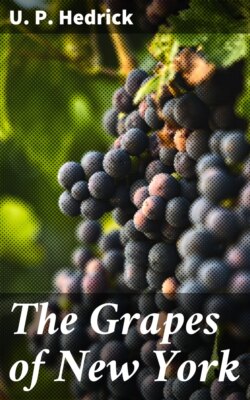Читать книгу The Grapes of New York - U. P. Hedrick - Страница 52
На сайте Литреса книга снята с продажи.
21. VITIS CANDICANS Engelm.
ОглавлениеTable of Contents
1. Engelmann, Gray’s Pl. Lindh., 2:166. 1845. 2. U. S. Pat. Off. Rpt., 1847:198. Mustang grape. 3. Engelmann, Gray’s Pl. Wright., 1:32. 1852. 4. Vanzandt, Gar. Mon., 1:166. 1859. Mustang grape. 5. Affleck, Mag. Hort., 26:98. 1860. Mustang grape. 6. Buckley, U. S. Pat. Off. Rpt., 1861:482. V. Mustangensis; Mustang grape. 7. Engelmann, Am. Nat., 2:321. 1868. Mustang grape. 8. Koch, Ill. Hort. Soc. Rpt., 1868:82. V. Mustangensis; Mustang grape. 9. Engelmann, Mo. Ent. Rpt., 1874:76. V. Mustangensis; Mustang grape. 10. Ib., Bush. Cat., 1883: 10, 11, 12, 14, 15. V. Mustangensis; Mustang grape. 11. Munson, Am. Hort. Soc. Rpt., 1885: 137. V. Mustangensis. 12. Ib., Am. Pom. Soc. Rpt., 1885:97, 98. Mustang grape. 13. Planchon, De Candolle’s Mon. Phan., 1887:323, 326. V. Mustangensis; Mustang grape. 14. Munson, Soc. Prom. Ag. Sci. Rpt., 1887:59. Mustang grape. 15. Ib., U. S. D. A. Pom. Bul., 3:10. 1890. 16. Ib., Bush. Cat., 1894:20, 22, 25. Mustang grape. 17. Ib., Rural N. Y., 56:610. 1897. Mustang. 18. Bailey, Gray’s Syn. Fl., 1:428. 1897. Mustang grape. 19. Munson, Tex. Sta. Bul., 56:232, 234, 240, 267. 1900. Mustang grape. 20. Viala and Ravaz, Am. Vines, 1903:42, 54.
Vine very vigorous, climbing; shoots and petioles densely woolly, whitish or rusty; diaphragm thick; tendrils intermittent (according to Munson, rarely four continuous). Leaves with medium to large stipules; blade small to medium, broadly cordate to reniform ovate, frequently resembling those of a poplar, entire or in young shoots and on young vines and sprouts usually deeply from three- to five-, or even seven-lobed; teeth shallow, sinuate; petiolar sinus shallow, wide, sometimes lacking; dull, slightly rugose above, dense whitish pubescence below. Clusters small. Berries medium to large, black, purple, green, or even whitish, thin blue bloom or bloomless. Seeds usually three or four, large, short, plump, blunt, notched; chalaza oval, depressed, indistinct; raphe a broad groove.
Candicans was described and named by Engelmann in his account of certain plants sent from Texas by Lindheimer. In 1861 it was described by Buckley who seems to have been unaware of the species having been previously named.
The habitat of this grape extends from southern Oklahoma, as a northern limit, southwesterly into Mexico. The western boundary is the Pecos River. It is found on dry, alluvial, sandy or limestone bottoms or on limestone bluff lands and is said to be especially abundant along upland ravines. Candicans grows well on limestone lands enduring as much as 60 per ct. of carbonate of lime in the soil. The species blooms shortly before Labrusca and a week later than Riparia. It requires the long hot summers of its native country and will stand extreme drouth but is not hardy to cold, ten or fifteen degrees below zero killing the vine outright unless protected; and a lesser degree of cold injuring it severely. The berries, which are large for wild vines, have thin skins under which there is a pigment which gives them, when first ripe, a fiery, pungent taste but which partly disappears with maturity. The berries are very persistent, clinging to the pedicel long after ripe. Candicans is difficult to propagate from cuttings. Its roots resist phylloxera fairly well. It makes a good stock for Vinifera vines in its native country but owing to the difficulty of propagation is seldom used for that purpose. In the early days of Texas it was much used for the making of wine but as it is deficient in sugar, and as the must retains the acrid, pungent flavor, it does not seem to be well adapted for this purpose. It is not regarded as having great promise for southern horticulture and certainly has none for the North.
